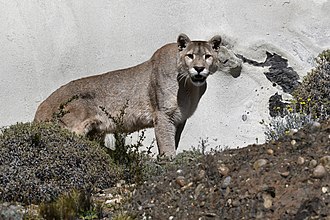
| Version | Summary | Created by | Modification | Content Size | Created at | Operation |
|---|---|---|---|---|---|---|
| 1 | Encyclopedia Editorial Office | -- | 1688 | 2024-02-28 07:43:53 |
Video Upload Options
The Cougar (Puma concolor), also known as the mountain lion, puma, or panther, is a large felid native to the Americas. Renowned for its elusive nature and wide distribution across diverse habitats, including forests, mountains, and deserts, the Cougar is one of the most adaptable and widespread carnivores in the Western Hemisphere. As a formidable apex predator, it plays a crucial role in regulating prey populations and maintaining ecosystem balance throughout its range.
1. Introduction
The Cougar (Puma concolor), also known as the mountain lion (Figure 1), puma, or panther, is a majestic and highly adaptable big cat species native to the Americas. Renowned for its solitary and elusive nature, the Cougar occupies a diverse range of habitats, including forests, mountains, deserts, and grasslands, demonstrating its remarkable ability to thrive in various environments. Sporting a sleek and muscular body, with a tawny coat and distinctive facial features, the Cougar is a formidable apex predator, equipped with powerful limbs, sharp claws, and keen senses to efficiently hunt a wide range of prey.

Figure 1. Cougar. The image is available under the terms and conditions of CC-BY-SA license (https://en.wikipedia.org/wiki/Cougar#/media/File:Torres_del_Paine_puma_JF2.jpg accessed on 23 February 2024).
With a broad diet that includes deer, elk, small mammals, and occasionally livestock, the Cougar plays a vital role in regulating prey populations and maintaining ecosystem balance. Despite its wide distribution and adaptability, the Cougar faces numerous threats, including habitat loss, fragmentation, poaching, and human-wildlife conflicts. Conservation efforts aimed at protecting Cougar habitat, mitigating conflicts with humans, and enforcing wildlife protection laws are crucial for ensuring the long-term survival of this iconic species in the Americas.
2. Morphology and Physical Characteristics
The reproductive biology of the Cougar is characterized by its solitary nature and flexible breeding patterns, which vary depending on factors such as geographic location, prey availability, and environmental conditions. Cougars do not have a specific breeding season, and mating can occur throughout the year in some regions, while in others, it may be more concentrated during certain times of the year.
Male Cougars, known as toms, establish territories that encompass the ranges of several females, known as queens. During the breeding season, toms may travel extensively in search of receptive females, sometimes covering large distances to locate potential mates. Mating typically occurs after a brief courtship period, which involves vocalizations, scent marking, and physical interactions between the mating pair.
After a gestation period of approximately 90 to 96 days, female Cougars give birth to a litter of one to six kittens, with two to four being more common. The kittens are born blind and helpless, relying entirely on their mother for nourishment and protection. Female Cougars are solely responsible for raising and caring for their offspring, nursing them for several months until they are old enough to begin accompanying her on hunting expeditions.
Young Cougars, known as cubs, remain with their mother for up to two years, during which time they learn essential hunting and survival skills. Once they reach sexual maturity at around two to three years of age, they will disperse to establish their own territories and seek out mates, continuing the cycle of reproduction.
Overall, the reproductive biology of the Cougar reflects its adaptability and resilience as a species, with flexible breeding patterns and maternal care strategies that contribute to the survival and success of its offspring in a variety of habitats across the Americas.




